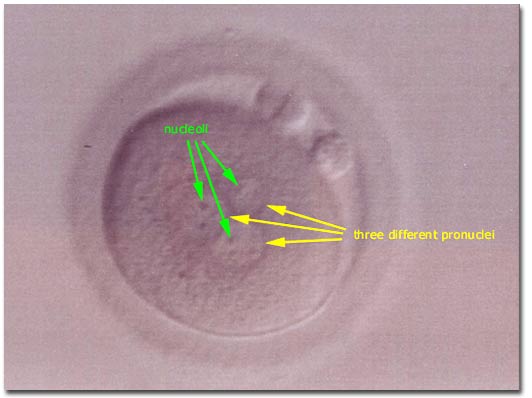|
Fertilized Human Egg with 3 Pronuclei

Photomicrograph of an abnormally fertilized human egg. This egg contains three pronuclei and each pronucleus is confirmed by the presence of nucleoli (small rounded masses within the pronucleus). During In Vitro Fertilization (IVF), polypronuclear embryos are occasionally seen (most often represent a small fraction of fertilized eggs).
The most common cause of 3 pronuclei in an egg is polyspermic fertilization (fertilization of the egg with more than one sperm). Each sperm will result in one pronucleus and the egg will have its own pronucleus. This results in 3 sets of the 23 chromosomes (normally there is only a pair of each of the 23 chromosomes in a fertilized human egg), which is a lethal mutation (chromosome abnormality that cannot result in a liveborn baby). These embryos should not be replaced into the womanís uterus at embryo transfer since they cannot result in a viable pregnancy. Research investigating the possibility of restoring a normal chromosome complement (23 pairs of chromosomes) by removing one of the (male) pronuclei is ongoing.
At IVF, polyspermic fertilization has been associated with maternal aging, a decrease in serum estradiol concentrations before administration of hCG during controlled ovarian hyperstimulation, egg immaturity, a high concentration of motile (morphologically normal or capacitated) sperm in the insemination medium, subzonal sperm injection (a microscopic technique designed to assist fertilization), and incubation of the eggs in suboptimal conditions (air, at high temperatures, or under alkali conditions).
|

|